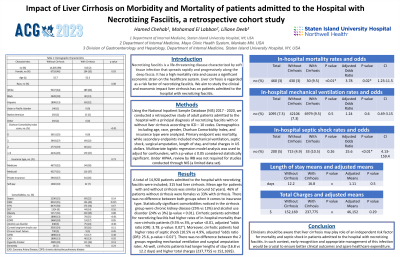Monday Poster Session
Category: Liver
P2436 - Impact of Liver Cirrhosis on Morbidity and Mortality of Patients Admitted to the Hospital With Necrotizing Fasciitis: A Retrospective Cohort Study
Monday, October 23, 2023
10:30 AM - 4:15 PM PT
Location: Exhibit Hall

Has Audio
- HC
Hamed Chehab, MD
Staten Island University Hospital/Northwell Health
New York, NY
Presenting Author(s)
Hamed Chehab, MD1, Mohamad El Labban, MBBCh2, Liliane Deeb, MD3
1Staten Island University Hospital/Northwell Health, New York, NY; 2Mayo Clinic Health System, Mankato, MN; 3Staten Island University Hospital, Staten Island, NY
Introduction: Necrotizing fasciitis is a life-threatening disease characterized by soft tissue infection that spreads rapidly and progressively along the deep fascia. It has a high mortality rate and causes significant economic strain on the healthcare system. Liver cirrhosis is regarded as a risk factor of necrotizing fasciitis. We aim to study the clinical and economic impact liver cirrhosis has on patients admitted to the hospital with necrotizing fasciitis.
Methods: Using the National Inpatient Sample Database (NIS) 2017 - 2020, we conducted a retrospective study of adult patients admitted to the hospital with a principal diagnosis of necrotizing fasciitis with or without liver cirrhosis according to ICD – 10 codes. Demographics including age, race, gender, Charlson Comorbidity Index, and insurance type were analyzed. Primary endpoint was mortality, while secondary endpoints were mechanical ventilation, septic shock, surgical amputation, length of stay, and total charges in US dollars. Multivariate logistic regression model analysis was used to adjust for confounders, with a p-value ≤ 0.05 considered statistically significant.
Results: A total of 14,920 patients admitted to the hospital with necrotizing fasciitis were included; 315 had liver cirrhosis. Mean age was around 52 years. 46% of patients without cirrhosis were females vs 33% with cirrhosis. There was no difference between both groups regarding insurance type. Statistically significant comorbidities noticed in the cirrhosis group were chronic kidney disease (25% vs 13%) and alcohol use disorder (24% vs 3%) (p-value < 0.01). Cirrhotic patients admitted for necrotizing fasciitis had higher rates of in-hospital mortality than non-cirrhotic patients (9.5% vs 3%, p-value < 0.01, adjusted “odds ratio (OR): 3.78. p-value: 0.02”). Moreover, cirrhotic patients had higher rates of septic shock (10.5% vs 4.9%, adjusted “odds ratio (OR): 25.6, p-value < 0.01”). There was no difference between the 2 groups regarding mechanical ventilation and surgical amputation rates. As well, cirrhotic patients had longer lengths of stay (16.8 vs 12.2 days) and higher total charges (237,775$ vs 152,169$).
Discussion: Clinicians should be aware that liver cirrhosis may play role of an independent risk factor for mortality and septic shock in patients admitted to the hospital with necrotizing fasciitis. In such context, early recognition and appropriate management of this infection would be crucial to ensure better clinical outcomes and spare healthcare expenditure.
Disclosures:
Hamed Chehab, MD1, Mohamad El Labban, MBBCh2, Liliane Deeb, MD3. P2436 - Impact of Liver Cirrhosis on Morbidity and Mortality of Patients Admitted to the Hospital With Necrotizing Fasciitis: A Retrospective Cohort Study, ACG 2023 Annual Scientific Meeting Abstracts. Vancouver, BC, Canada: American College of Gastroenterology.
1Staten Island University Hospital/Northwell Health, New York, NY; 2Mayo Clinic Health System, Mankato, MN; 3Staten Island University Hospital, Staten Island, NY
Introduction: Necrotizing fasciitis is a life-threatening disease characterized by soft tissue infection that spreads rapidly and progressively along the deep fascia. It has a high mortality rate and causes significant economic strain on the healthcare system. Liver cirrhosis is regarded as a risk factor of necrotizing fasciitis. We aim to study the clinical and economic impact liver cirrhosis has on patients admitted to the hospital with necrotizing fasciitis.
Methods: Using the National Inpatient Sample Database (NIS) 2017 - 2020, we conducted a retrospective study of adult patients admitted to the hospital with a principal diagnosis of necrotizing fasciitis with or without liver cirrhosis according to ICD – 10 codes. Demographics including age, race, gender, Charlson Comorbidity Index, and insurance type were analyzed. Primary endpoint was mortality, while secondary endpoints were mechanical ventilation, septic shock, surgical amputation, length of stay, and total charges in US dollars. Multivariate logistic regression model analysis was used to adjust for confounders, with a p-value ≤ 0.05 considered statistically significant.
Results: A total of 14,920 patients admitted to the hospital with necrotizing fasciitis were included; 315 had liver cirrhosis. Mean age was around 52 years. 46% of patients without cirrhosis were females vs 33% with cirrhosis. There was no difference between both groups regarding insurance type. Statistically significant comorbidities noticed in the cirrhosis group were chronic kidney disease (25% vs 13%) and alcohol use disorder (24% vs 3%) (p-value < 0.01). Cirrhotic patients admitted for necrotizing fasciitis had higher rates of in-hospital mortality than non-cirrhotic patients (9.5% vs 3%, p-value < 0.01, adjusted “odds ratio (OR): 3.78. p-value: 0.02”). Moreover, cirrhotic patients had higher rates of septic shock (10.5% vs 4.9%, adjusted “odds ratio (OR): 25.6, p-value < 0.01”). There was no difference between the 2 groups regarding mechanical ventilation and surgical amputation rates. As well, cirrhotic patients had longer lengths of stay (16.8 vs 12.2 days) and higher total charges (237,775$ vs 152,169$).
Discussion: Clinicians should be aware that liver cirrhosis may play role of an independent risk factor for mortality and septic shock in patients admitted to the hospital with necrotizing fasciitis. In such context, early recognition and appropriate management of this infection would be crucial to ensure better clinical outcomes and spare healthcare expenditure.
Disclosures:
Hamed Chehab indicated no relevant financial relationships.
Mohamad El Labban indicated no relevant financial relationships.
Liliane Deeb indicated no relevant financial relationships.
Hamed Chehab, MD1, Mohamad El Labban, MBBCh2, Liliane Deeb, MD3. P2436 - Impact of Liver Cirrhosis on Morbidity and Mortality of Patients Admitted to the Hospital With Necrotizing Fasciitis: A Retrospective Cohort Study, ACG 2023 Annual Scientific Meeting Abstracts. Vancouver, BC, Canada: American College of Gastroenterology.
